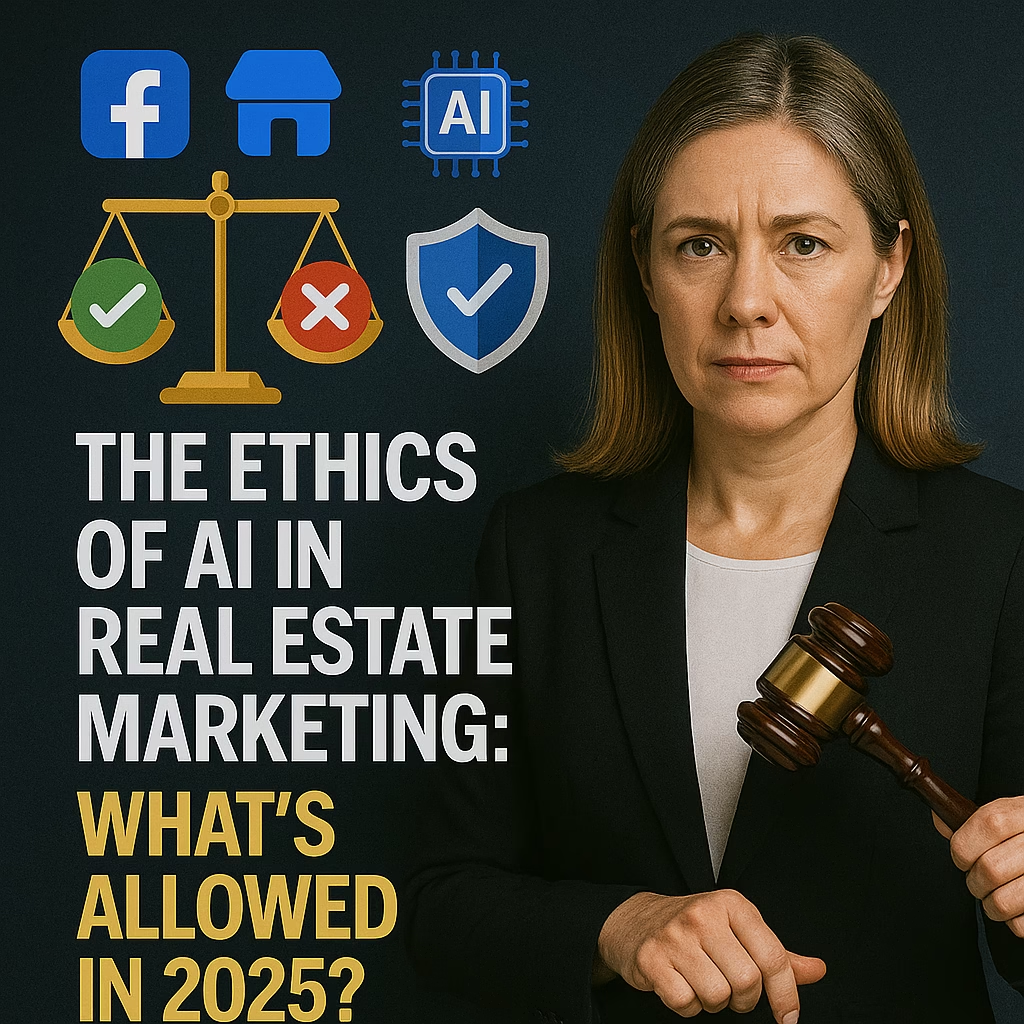The Ethics of AI in Real Estate Marketing: What's Allowed in 2025?
Use AI to help—not to mislead. This guide shows practical, compliant ways to market listings while protecting trust.
Introduction
The Ethics of AI in Real Estate Marketing: What's Allowed in 2025? is a practical framework for brokers, teams, and property managers. It’s not legal advice—use it to design sensible workflows, disclosures, and reviews so AI speeds you up without crossing lines.
Important: Always follow your brokerage rules and local laws. Keep a human in the loop for anything public, precise, or safety-critical.
Expanded Table of Contents
- 1) Why ethics is a growth strategy, not a brake
- 2) Five core principles (w/ examples)
- 3) What’s generally allowed with guardrails
- 4) Use with caution: gray zones to review
- 5) Hard no’s: practices to avoid
- 6) Fair Housing-aware marketing basics
- 7) Synthetic media: virtual staging, sky swaps, and labels
- 8) Privacy, consent, retention, and data minimization
- 9) Chatbots & autoresponders: transparency and escalation
- 10) Accessibility: alt text, captions, and readable layouts
- 11) Vendor due diligence checklist (contract must-haves)
- 12) Governance: roles, approvals, incident response
- 13) Ethics KPIs you can actually track
- 14) Copyable disclosure templates
- 15) 30–60–90 day rollout plan
- 16) Troubleshooting & decision table
- 17) 25 Frequently Asked Questions
- 18) 25 Extra Keywords
1) Why ethics is a growth strategy, not a brake
- Trust compounds: Transparent marketing reduces rework, complaints, and fallout.
- Consistency wins: A simple review process beats ad-hoc fixes.
- Speed with safety: Clear guardrails let assistants and vendors move faster.
2) Five core principles (w/ examples)
- Transparency: Label AI assistance (e.g., “virtually staged,” “AI-assisted summary”).
- Consent: Get permission before using client data to train or personalize.
- Fairness: No demographic steering; center features and budget, not people.
- Accuracy: Use verifiable data; ban “guaranteed” claims.
- Accountability: Assign approvers; log changes; fix fast when wrong.
3) What’s generally allowed with guardrails
Green-light uses
- AI copyediting for clarity and grammar
- Summarizing market stats with source links
- AI translations with human spot checks
- Virtually staged images labeled as such
- Lead-sorting and inbox triage (no demographic inference)
Guardrails
- Human approval before publishing
- Disclosure footers on AI-assisted pages
- No sensitive attributes, ever
- Keep originals alongside edited assets
4) Use with caution: gray zones to review
- Neighborhood “vibes” text—stick to verifiable amenities and transit
- Price predictions—present as estimates with ranges and dates
- Automated follow-ups—respect quiet hours and opt-outs
- Third-party data enrichment—confirm lawful basis and client consent
5) Hard no’s: practices to avoid
- Altering photos to add/remove material features without disclosure
- Targeting or excluding protected classes—ever
- Fabricating testimonials, reviews, or offers
- Scraping personal data without permission or a lawful basis
6) Fair Housing-aware marketing basics
- Focus copy on property features, price, location (not people)
- Use neutral phrasing; avoid “ideal for…” demographics
- When in doubt, escalate to your broker/compliance lead
7) Synthetic media: virtual staging, sky swaps, and labels
| Use | Usually OK | Requires |
|---|---|---|
| Virtual staging | Yes | “Virtually staged” label; no structural changes |
| Sky/lighting edits | Yes | No concealment of defects; keep originals |
| AI floor plans | Yes | “Illustrative only”—not for measurements |
8) Privacy, consent, retention, and data minimization
- Collect the minimum data needed for the task
- Consent for training or personalization beyond service delivery
- Retain only as long as necessary; define deletion triggers
- Protect with access controls and vendor NDAs
9) Chatbots & autoresponders: transparency and escalation
- Open with: “I’m an assistant; I can connect you with an agent.”
- Escalate to humans for pricing, contract terms, or sensitive questions
- Log conversations; review weekly for quality and bias
10) Accessibility: alt text, captions, and readable layouts
- Write descriptive alt text: room, angle, key feature
- Caption short videos and add transcripts for long tours
- Use large contrast-friendly fonts; avoid text-heavy images
11) Vendor due diligence checklist (contract must-haves)
- Data ownership remains with you; no model training on your data by default
- Clear deletion on termination
- Sub-processor transparency and security standards
- Uptime/SLA and incident response timelines
12) Governance: roles, approvals, incident response
RACI snapshot
- Agent: drafts & disclosures
- Marketing lead: QA & bias checks
- Broker: final approval & escalation
- Ops: vendor reviews & logging
Playbook
- Pre-publish checklist (copy, images, disclosures)
- Post-publish monitoring (flags, corrections)
- Incident template (what, where, fix, notify)
13) Ethics KPIs you can actually track
Quality
Error rate, correction time
Trust
Complaint rate, review tone
Compliance
Disclosure coverage, flagged assets
Access
Alt-text coverage, caption rate
Add a monthly audit: 10 random assets, score each KPI, publish lessons to the team.
14) Copyable disclosure templates
Virtual Staging:
This image is **virtually staged** to showcase possible furnishings. Fixtures and dimensions may differ.
AI Assistance:
This page includes **AI-assisted summaries** reviewed by our team for accuracy.
Market Estimates:
Figures are **estimates** based on available data as of {Month Year}. Not a guarantee; speak with an agent for specifics.15) 30–60–90 day rollout plan
Days 1–30 (Foundation)
- Adopt the five principles; publish a 1-page policy
- Enable disclosures on AI-assisted pages
- Start an image log: originals + edits + labels
Days 31–60 (Momentum)
- Vendor contract review (training, deletion, security)
- Bias checklists in copy QA; add accessibility pass
- Launch chatbot escalation rules
Days 61–90 (Scale)
- Quarterly audits and training refresh
- Public “Corrections & Updates” page for transparency
- Turn KPIs into a dashboard for leadership
16) Troubleshooting & decision table
| Scenario | Risk | Decision |
|---|---|---|
| AI rewrites a testimonial | Misrepresentation | Use original wording or get client approval |
| Virtual staging removes a wall | Material change | Prohibit or label as concept only + architectural verification |
| Chatbot gives price advice | Reliance/liability | Escalate to agent automatically |
| Model proposes audience based on life stage | Fair Housing | Reject; use feature-based targeting |
17) 25 Frequently Asked Questions
1) What is “The Ethics of AI in Real Estate Marketing: What's Allowed in 2025?”
A non-legal, practical framework to market responsibly with AI.
2) Do I have to disclose AI use?
Best practice: yes—especially for summaries, estimates, and synthetic visuals.
3) Are AI listing descriptions okay?
Yes with human review and neutral, factual language.
4) Can I virtually remove clutter?
Minor cosmetic cleanup is fine; don’t hide defects or change structure.
5) Can AI propose audiences?
Use property features and budget—not demographics or proxies.
6) Is auto-DMing leads acceptable?
With consent, quiet hours, clear opt-out, and helpful tone.
7) What about market value estimates?
Share as estimates with methods and dates; avoid guarantees.
8) Can AI translate contracts?
Use for drafts only; have a professional review.
9) Who approves AI content?
Assign a QA approver; broker signs off on sensitive items.
10) Do I need alt text?
Yes—describe rooms and any virtual elements plainly.
11) Is scraping allowed?
Avoid scraping personal data; prefer consented sources.
12) Can I enhance skies?
Yes—don’t obscure property realities; keep originals.
13) How do I prevent bias?
Ban sensitive terms, use a checklist, and train staff.
14) Are AI floor plans okay?
Label as illustrative; not for precise measurements.
15) Should the bot say it’s a bot?
Yes—be transparent and offer a human handoff.
16) Can I feed emails into AI?
Get consent; minimize data; redact PII where possible.
17) Do I need a retention policy?
Yes—define how long data stays and how it’s deleted.
18) What about children’s data?
Avoid collecting it; escalate any edge cases to legal/compliance.
19) Can AI rate leads?
Yes, based on behavior (responses, page views), not demographics.
20) Should I label AI-generated voice-overs?
Yes—note that narration is synthetic.
21) Are deepfake tours acceptable?
No—do not impersonate sellers/buyers or alter facts.
22) Can AI summarize inspections?
Only with the full report available and disclaimers about interpretation limits.
23) How often to review policies?
Quarterly or when tools change; record staff sign-off.
24) What if a mistake goes live?
Correct promptly, notify impacted parties, and document fixes.
25) First step today?
Add disclosures to AI-assisted pages and start a pre-publish checklist.
18) 25 Extra Keywords
- The Ethics of AI in Real Estate Marketing: What's Allowed in 2025?
- ethical ai real estate
- ai disclosure real estate
- virtual staging label
- synthetic media real estate
- fair housing ai marketing
- bias-free listing copy
- real estate chatbot ethics
- privacy consent property data
- accessibility alt text listings
- transparent ai estimates
- ai vendor due diligence
- data retention policy real estate
- ai governance brokerage
- ai marketing compliance
- ai floor plan disclaimer
- neighborhood description ethics
- ai translation real estate
- lead scoring without bias
- responsible audience targeting
- ai incident response
- ai audit checklist
- ethical listing photography
- real estate transparency notice
- 2025 real estate ai policy

















